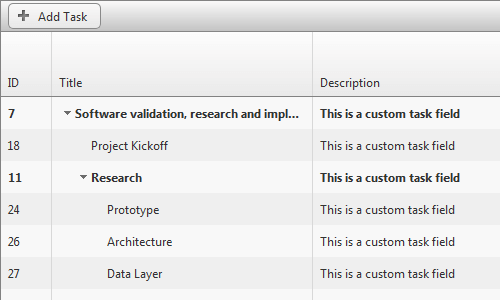Custom Tasks Fields
With the 2014 Q2 SP1 version you can now use Custom Task objects to populate the Gantt, providing you with the ability to add user defined Properties to be shown in the control.
In order to use a custom Task class you have to create a custom Provider, like the one shown in the Use CustomFields in Gantt with a simple CustomProvider KB article or the Custom EntityFramework Provider help article article. Sample Code Library can be downloaded from here.

Adding custom fields to Task with custom Entity provider
Use previous help article to set up custom Entity Provider
-
Create Custom Task class, inheriting from Task.
C#
public class CustomTask : Task { public CustomTask() : base() { } }VB
Public Class CustomTask Inherits Task Public Sub New() MyBase.New() End Sub End Class -
Add custom property
C#
public class CustomTask : Task { ... public string Description { get { return (string)(ViewState["Description"] ?? ""); } set { ViewState["Description"] = value; } } }VB
Public Class CustomTask Inherits Task ... Public Property Description() As String Get Return DirectCast(If(ViewState("Description"), ""), String) End Get Set(value As String) ViewState("Description") = value End Set End Property End Class -
Override GetSerializationData and LoadFromDictionary methods
C#
public class CustomTask : Task { ... protected override IDictionary<string, object> GetSerializationData() { var dict = base.GetSerializationData(); dict["Description"] = Description; return dict; } public override void LoadFromDictionary(System.Collections.IDictionary values) { base.LoadFromDictionary(values); Description = (string)values["Description"]; } }VB
Public Class CustomTask Inherits Task ... Protected Overrides Function GetSerializationData() As IDictionary(Of String, Object) Dim dict = MyBase.GetSerializationData() dict("Description") = Description Return dict End Function Public Overrides Sub LoadFromDictionary(values As System.Collections.IDictionary) MyBase.LoadFromDictionary(values) Description = DirectCast(values("Description"), String) End Sub End Class -
Create new TaskFactory
C#
public class CustomGanttTaskFactory : ITaskFactory { Task ITaskFactory.CreateTask() { return new CustomTask(); } }VB
Public Class CustomGanttTaskFactory Implements ITaskFactory Private Function ITaskFactory_CreateTask() As Task Implements ITaskFactory.CreateTask Return New CustomTask() End Function End Class -
Override Provider TaskFactory property to return new factory
C#
public class GanttCustomProvider : GanttProviderBase { public override ITaskFactory TaskFactory { get { return new CustomGanttTaskFactory(); } } ... }VB
Public Class GanttCustomProvider Inherits GanttProviderBase Public Overrides ReadOnly Property TaskFactory() As ITaskFactory Get Return New CustomGanttTaskFactory() End Get End Property ... End Class -
Update Provider GetTasks Method
C#
public override List<ITask> GetTasks() { var tasks = new List<ITask>(); using (var db = new GanttDatabaseEntities()) { tasks.AddRange(db.GanttTasks.ToList().Select(task => new CustomTask { ID = task.ID, ParentID = task.ParentID, ... Description = task.Description })); } return tasks; }VB
Public Overrides Function GetTasks() As List(Of ITask) Dim tasks = New List(Of ITask)() Using db = New GanttDatabaseEntities() tasks.AddRange(db.GanttTasks.ToList().[Select](Function(task) New CustomTask() With { _ Key .ID = task.ID, _ Key .ParentID = task.ParentID, _ ... Key .Description = task.Description _ })) End Using Return tasks End Function -
Update Provider ToEntityTask Method
C#
private GanttTask ToEntityTask(ITask srcTask) { return new GanttTask { ID = (int)srcTask.ID, ParentID = (int?)srcTask.ParentID, ... Description = ((CustomTask)srcTask).Description }; }VB
Private Function ToEntityTask(srcTask As ITask) As GanttTask Return New GanttTask() With { _ Key .ID = CInt(srcTask.ID), _ Key .ParentID = DirectCast(srcTask.ParentID, System.Nullable(Of Integer)), _ ... Key .Description = DirectCast(srcTask, CustomTask).Description _ } End Function
Defining Custom Tasks Fields
To add new Custom Task Field you will have to:
Set the AutoGenerateColumns property to false.
Define new GanttBoundColumn in the Columns collection.
Define new GanttCustomField in the CustomTaskFields collection.
-
Defining Custom Columns:
-
In the Markup:
ASP.NET
<telerik:RadGantt RenderMode="Lightweight" runat="server" ID="RadGantt1" SelectedView="WeekView" AutoGenerateColumns="false"> <Columns> <telerik:GanttBoundColumn DataField="ID" Width="90px"></telerik:GanttBoundColumn> <telerik:GanttBoundColumn DataField="Title"></telerik:GanttBoundColumn> <telerik:GanttBoundColumn DataField="Description" HeaderText="Description" DataType="String" UniqueName="Description"> </telerik:GanttBoundColumn> </Columns> <CustomTaskFields> <telerik:GanttCustomField PropertyName="Description" ClientPropertyName="description" Type="String" /> </CustomTaskFields> </telerik:RadGantt> -
In the Code Behind
C#
protected void Page_Load(object sender, EventArgs e) { GanttCustomField customField = new GanttCustomField(); customField.Type = GanttCustomFieldType.String; customField.PropertyName = "Description"; customField.ClientPropertyName = "description"; RadGantt1.CustomTaskFields.Add(customField); }VB
Protected Sub Page_Load(sender As Object, e As EventArgs) Handles Me.Load Dim customField As New GanttCustomField() customField.Type = GanttCustomFieldType.[String] customField.PropertyName = "Description" customField.ClientPropertyName = "description" RadGantt1.CustomTaskFields.Add(customField) End Sub
-
Access Custom Task Field on the Client
The task generates getter and setter functions for the custom field client objects in the format get_<customFieldClientPropertyName>() and set_<customFieldClientPropertyName>(newValue). For example:
var gantt = $find("<%= RadGantt1.ClientID %>");
var task = gantt.get_tasks().getTask(0);
alert(task.get_description());
task.set_decription("my new description");